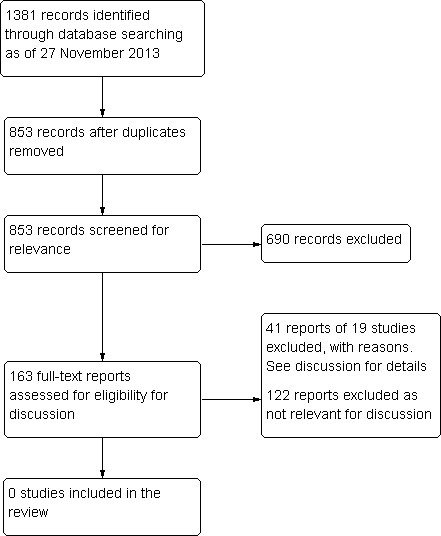| Study | Study design | Study dates | Country | Follow‐up | Number of participants | Number with repeat PK | Funding source and declarations of interest |
| Boston Type 1 KPro Study | Multicenter retrospective and prospective case
series | 2003‐2008 | 18 sites in the USA | Mean 17 (range 1 week to 6.1 years) | 300 (300 eyes) | 244/300 (81.3%) | "No surgeons in the study group have any proprietary interest in the Boston Type 1 keratoprosthesis." |
| Aldave 2012a | Retrospective case series | 2004‐2011 | USA (Jules Stein Eye Institute) | Mean 24 months (range 0 to 84 months) | 94 (98 eyes, 110 devices) | 82/98 (83.7%) eyes | "The author(s) have no proprietary or commercial interest in any materials discussed in this article." |
| Aldave 2012b | Retrospective case series | 2004‐2011 | Armenia, India, Indonesia, Nepal, Philippines, Russia, and Saudi Arabia | Mean 14.2 months (range 0 to 48 months) | 100 (107 eyes, 113 devices) | 74/107 (69.2%) eyes | "The author(s) have no proprietary or commercial interest in any materials discussed in this article." |
| Chew 2009 | Retrospective case series | 2005‐2007 | USA (Wills Eye Institute) | Mean 16 months (range 6 to 28 months) | 37 (37 eyes) | 29/37 (78.4%) | "Dr. H. F. Chew was supported by the E. A. Baker Fellowship Fund Grant from the Canadian National Institute for the Blind." |
| Dunlap 2010 | Retrospective case series | 2004‐2008 | USA (Wilmer Eye Institute and University of Rochester Eye Institute) | 6 months | 122 (126 eyes) | 112/126 (88.9%) eyes | "The authors have no proprietary or commercial interest in any of the materials discussed in this article." |
| Greiner 2011 | Retrospective case series | 2004‐2008 | USA (University of California, Davis) | Mean 19 months (range 1 to 48 months) | 28 (30 eyes) | 26/30 (86.7%) eyes | "The author(s) have no proprietary or commercial interest in any materials discussed in this article." |
| Guell 2011 | Retrospective case series | 2006‐2011 | Spain (Instituto Microcirugia Ocular of Barcelona) | Mean 20 months (range 1 to 56 months) | 53 (54 eyes) | 49/54 (90.7%) eyes | "This work has been done with the help of the Ophthalmological Society of the Valencian Community, Valencia, Spain. The first author of the work has been awarded a fellowship for further study of residents at the Ocular Microsurgery Institute of Barcelona, sponsored by Pfizer."; "The authors have no financial or proprietary interest in the materials presented herein." |
| Kamyar 2012 | Retrospective case series | 2003‐2009 | USA (Kellogg Eye Center, University of Michigan) | Mean 17 months (range 3 to 67 months) | 29 (30 eyes) | 23/30 (76.7%) eyes | "Supported in part by a departmental grant from the Research to Prevent Blindness (RPB), the RPB Lew R.Wasserman Merit Award, and the National Eye Institute K23 Mentored Clinician Scientist Award." |
| Koller 2012 | Retrospective case series | 2009‐2011 | Germany (Neuhann & Colleagues) | Mean 9.1 months (range 1 to 21 months) | 14 (14 eyes) | 13/14 (92.9%) | "The corresponding author indicates no conflict of interests." |
| Patel 2012 | Retrospective case series | 2006‐2010 | USA (New York Eye and Ear Infirmary) | Mean 21.5 months (range 3 to 47 months) | 51 (58 eyes) | 47/58 (81.0%) eyes | "The authors declare no conflict of interest." |
| Shihadeh 2012 | Retrospective case series | 2007‐2010 | Jordan (King Abdullah University Hospital) | Mean 18 months (range 3 to 36 months) | 19 (20 eyes) | 19/20 (95%) eyes | "Source of Support: Nil, Conflict of Interest: None declared." |
| Talajic 2012 | Retrospective case series | 2008‐2009 | Canada (Centre Hospitalier de l’Université de Montréal, Hôpital Notre‐Dame), | Mean 16.5 months | 38 (38 eyes) | 25/38 (65.8%) eyes | "Supported by a research grant from the Fonds de Recherche en Ophthalmologie de l’Université de Montréal, Montreal, Canada; and a Resident Research Grant from Pfizer Canada (Kirkland, Canada)"; "The authors indicate no financial conflict of interest." |
| Early model of Boston keratoprosthesis (known as Dohlman‐Doane keratoprosthesis) |
| Aquavella 2005 | Retrospective case series | 2003‐2005 | USA (University of Rochester Eye Institute) | 12 months | 25 (25 eyes) | 22/25 (88%) | "The authors have no proprietary interest in any products mentioned in this article." |
| Harissi‐Dagher 2007 | Retrospective case series | 1990‐2004 | USA (Massachusetts Eye and Ear Infirmary) | Mean 35 months (range 1 to 108 months) | 128 (157 eyes) | 157/157 (100%) eyes | "Supported by a Massachusetts Eye and Ear Infirmary fund and the Alcon Research Institute award." |


